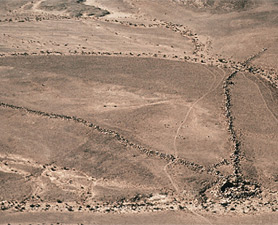 I was really intrigued this week by a news story out of Israel that attracted very little attention in the media.   The story had nothing to do with biblical archaeology, was completely unrelated to Dead Sea Scrolls, and had no bearing at all on the increasingly bitter debate over the politicization of archaeology in Israel.  No, this was a story of a very different stripe.  It focused on some mysterious lines that stretch along the stony deserts of Israel, Egypt and Jordan.  The longest extends 40 miles.
I was really intrigued this week by a news story out of Israel that attracted very little attention in the media.   The story had nothing to do with biblical archaeology, was completely unrelated to Dead Sea Scrolls, and had no bearing at all on the increasingly bitter debate over the politicization of archaeology in Israel.  No, this was a story of a very different stripe.  It focused on some mysterious lines that stretch along the stony deserts of Israel, Egypt and Jordan.  The longest extends 40 miles.
Pilots in the region have long wondered what purpose these lines served.  Now a new study by Uzi Avner, an archaeologist at Ben-Gurion University-Eilat, proposes a very plausible answer.  In a paper to be published in the Journal of Arid Environments in July, Avner suggests that the low stone walls are funnel-shaped drive lanes that ancient hunters once used to drive herds of gazelles and other fleet-footed game into killing pits in natural hollows.
Archaeologists have found similar systems in many parts of the world, and I think they are among the most ingenious hunting techniques ever devised by prehistoric humans.  I’ve written about one of the most famous here before—5,700-year-old Head-Smashed-In Buffalo Jump in southern Alberta.  But for those who missed that,  I’ll just briefly recap how it worked.
Before the Spanish introduced horses to the Americas, Native Americans hunted bison on foot.  To do so, they constructed long funnel-shaped lines of stone cairns that led to the edge of a precipice.  On the appointed day,  a runner wearing a bison hide would lure an unsuspecting herd into the drive lanes and towards the precipice by imitating a bleating calf.  When the animals finally caught wind of danger, they began stampeding toward the cliff.
And here’s the part that has always fascinated me.  A continuous carpet of grass extends right to the cliff edge and seems to blend into the prairie in the far distance—an optical illusion of continuous ground.  So the front animals would have been unable to see the precipice that loomed ahead until it was too late.  Jack Brink,  an archaeologist at the Royal Alberta Museum in Edmonton has calculated that the hunters at Head-Smashed-In dispatched as many as 250 animals in one go—amassing nearly 145,000 pounds of meat.
But prehistoric hunters used similar systems to hunt all manner of game. Once,  while travelling by helicopter across a sweeping ridge in the northern Yukon, I spied two long lines of what seemed to be spaced, upright wooden logs, each casting a dark shadow on the ground.  My companion, Jacques Cinq-Mars, then an archaeologist at the Canadian Museum of Civilization, told me that it was a caribou fence,  for funneling the animals into a pound or corral where hunters could spear them.
All this, of course, raises an intriguing question.   When did humans first begin hunting in this clever fashion?  No one really knows, but in 1978 American archaeologist Thomas Kehoe noticed something very familiar in the 17,000-year-old cave art of Lascaux in France.  Kehoe, who was then teaching at the University of Tübingen in Germany,  had spent seven years living with the Blackfeet tribe in Montana, and he had made a particular study of ancient bison hunting.
As Kehoe gazed at the south wall of Lascaux’s Axial Gallery, he noticed two dotted lines funneling into a painted rectangle.  The dots resembled stone cairns and the lines looked suspiciously like a drive lane leading to a trap—a rectangular corral. Kehoe looked more closely.  A herd of horses—a favorite prey of some Upper Paleolithic hunters—appeared to be stampeding through the lanes.
Standing back, Kehoe noticed paintings of bovines,  ibexes and reindeer skidding into four other corrals.  And the more he looked around,  the more he felt at home.  Even a controversial two-horned figure in the main Rotunda struck a familiar chord.  “It looked more like a man in some sort of camouflage,†Kehoe once told me.  “I think he is the runner bringing them in.â€
I think this form of communal hunting  is very, very old.   And the story out of Israel this week adds another cool chapter to its history.
Photo from Ben-Gurion University-Eilat
This entry was posted by Heather Pringle on
Friday, April 30, 2010.
Discussion of this blog entry is now closed.
Comments posted here do not represent the views or policies of the Archaeological Institute of America.

